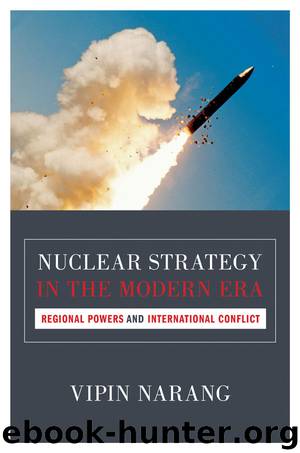Nuclear Strategy in the Modern Era: Regional Powers and International Conflict (Princeton Studies in International History and Politics) by Vipin Narang

Author:Vipin Narang [Narang, Vipin]
Language: eng
Format: epub
Publisher: Princeton University Press
Published: 2014-05-25T06:00:00+00:00
FRANCE AFTER THE COLD WAR: ASYMMETRIC ESCALATION TOUS AZIMUTS
After the dissolution of the Soviet Union, France was faced with a choice of how to operationalize its nuclear forces. The United Kingdom—save the tactical forces under NATO control—decided to shift to a sea-based nuclear deterrent as a cost-saving measure, even though all forces were effectively leased from the United States and were still coordinated with NATO forces and American deterrent patrols. On the one hand, the primary threat that pushed France toward an asymmetric escalation posture—the conventionally superior, nuclear-armed Soviet Union—largely disappeared. This gave France the latitude to shift to an assured retaliation posture, since it no longer faced an acute conventional existential threat. On the other hand, given that France possessed the technology, structures, organizational capacity, and finances to maintain an asymmetric escalation posture, it could also choose to hedge against the emergence of future threats by retaining its asymmetric escalation posture. It chose the latter, retiring some of the Soviet-specific tactical nuclear delivery vehicles but maintaining a robust air-deliverable tactical capability in addition to a robust sea-based strategic deterrent to deter future regional and major power threats, from wherever they might emerge (tous azimuts).49
France’s post–Cold War capability shift included several features, designed to consolidate France’s strategic forces at sea to make them virtually invulnerable to a potential first strike and to retire land-based tactical forces and rely entirely on an air-based tactical nuclear capability with the Mirage and Rafale deliverable Air-Sol Moyenne Portee (ASMP). That is, the shift recognized that the Soviet Union was no longer an acute threat, and so systems that were largely Soviet-specific (the Plutons, S2/S3s, etc., whose ranges were suitable largely for the USSR) were retired. The SLBM capability was enhanced to provide strategic reach against emerging potential adversaries, and the aircraft-deliverable ASMP was the primary tactical nuclear option that could also be used against a variety of potential threats.50 In 1996, following much debate about whether to replace the S3D silo-based ballistic missiles deployed at the Plateau d’Albion, President Chirac’s government decided to retire the land-based leg of France’s triad and not to replace them with the S45. Instead, France would rely on its new class of SSBNs for strategic deterrence, the Triomphant class ballistic missile submarines, which began replacing the Redoubtable class submarines in the mid-1990s. France will ultimately operate four Triomphant class submarines, allowing it to maintain a submarine continuously on deterrent patrol, each equipped with 16 M45 SLBMs with a range of 4,000km, each with up to 6 MIRVed warheads. In the near future, France will replace the M45 with the upgraded M51 SLBM which has a range of 6,000km with a full payload of 6 MIRVed warheads and accompanying penetration aids to defeat missile defenses.51 Thus, France’s strategic forces have now been consolidated into a single sea leg which, since deterrent patrol routes can shift according to the threat environment, is expected to provide sufficient strategic capability against future potential threats globally.
However, France made the critical decision to not eliminate its tactical nuclear forces after the Cold War.
Download
This site does not store any files on its server. We only index and link to content provided by other sites. Please contact the content providers to delete copyright contents if any and email us, we'll remove relevant links or contents immediately.
| Africa | Americas |
| Arctic & Antarctica | Asia |
| Australia & Oceania | Europe |
| Middle East | Russia |
| United States | World |
| Ancient Civilizations | Military |
| Historical Study & Educational Resources |
The Radium Girls by Kate Moore(11877)
100 Deadly Skills by Clint Emerson(4808)
Rise and Kill First by Ronen Bergman(4663)
The Templars by Dan Jones(4600)
The Doomsday Machine by Daniel Ellsberg(4380)
The Rape of Nanking by Iris Chang(4108)
Killing England by Bill O'Reilly(3931)
Hitler in Los Angeles by Steven J. Ross(3872)
Stalin by Stephen Kotkin(3831)
12 Strong by Doug Stanton(3460)
Hitler's Monsters by Eric Kurlander(3245)
Blood and Sand by Alex Von Tunzelmann(3106)
Darkest Hour by Anthony McCarten(3044)
The Code Book by Simon Singh(3031)
The Art of War Visualized by Jessica Hagy(2897)
Hitler's Flying Saucers: A Guide to German Flying Discs of the Second World War by Stevens Henry(2670)
Babylon's Ark by Lawrence Anthony(2498)
The Second World Wars by Victor Davis Hanson(2455)
Tobruk by Peter Fitzsimons(2420)
